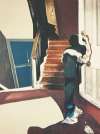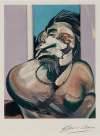Bull
Fight
Bull Fight comprises Francis Bacon's lithographs after paintings depicting Spanish bullfights, possessed with Bacon's typically hellish ambiguity of form. Yet the subject matter itself is clearer than other bodies of Bacon's work, causing the eerie fusion of figures to generate dynamic movement in an evocation of the tussle depicted.
Francis Bacon Bull Fight For sale
Bull Fight Value (5 Years)
Sales data across the Bull Fight series by Francis Bacon varies by print. While standout works have sold at auction for up to £23665, other editions in the series remain rare to market or have yet to appear publicly for sale. Of those tracked, average selling prices have ranged from £23665 to £23665, with an annual growth rate of 8.91% across available data. Collectors should note the discrepancy in performance between more visible and lesser-seen editions when considering value potential in this series.
Bull Fight Market value
Auction Results
| Artwork | Auction Date | Auction House | Return to Seller | Hammer Price | Buyer Paid |
|---|---|---|---|---|---|
 Second Version Of Study For Bullfight No. 1 Francis Bacon Signed Print | 23 Feb 2024 | Christie's New York | £18,700 | £22,000 | £30,000 |
 Study For Bullfight No. 2 Francis Bacon Signed Print | 22 Oct 2018 | Doyle Auctioneers & Appraisers | £8,925 | £10,500 | £14,500 |
Sell Your Art
with Us
with Us
Join Our Network of Collectors. Buy, Sell and Track Demand
Meaning & Analysis
Bull Fight comprises a collection of lithograph prints by Irish-born British artist, Francis Bacon. Each of the prints were made after paintings that depict bullfighting – a popular pastime in Spain, Portugal, southern France, and some Hispanic American countries, such as Ecuador and Peru. In Study For Bullfight (1989), the lower portion of a human figure stands with one leg upheld in triumph; at thigh-level, what appears to be a bull’s horn – also surrounded by eminently human, flesh-coloured tones – juts out of a block-coloured background with a threatening dynamism. An eerie snapshot of truncated human form, the piece commands our attention by way of this geometric framing device – a common feature of Bacon’s paintings.
Portraying a markedly less ambiguous subject matter, Study For Bullfight (left panel) (1971) depicts a bullfight in full swing. This print is a copy of Bacon’s original 1969 painting,Study For Bullfight No. 1, and was issued on the occasion of Bacon’s retrospective at Paris’s Grand Palais. Sandy, orange tones recall those of the corrida, which Bacon visited frequently on his travels throughout southern France and Spain, whilst a segment of greyer tones to the right of the composition offer a snapshot of a baying audience. In front of the audience, an ancient Roman standard flies high in a metaphorical evocation of bullfighting’s links to gladiatorial combat. Study For Bullfight (right panel) (1980) is a lithograph print of the 1969 painting, Study For A Bullfight, Number 2 (1969), which is currently housed at France’s Musée des beaux-arts de Lyon and is based on Study For A Bullfight No. 1. In Study For Bullfight (centre panel) (1990), we notice a similar image; the omission of the biomorphic audience and its replacement by a rectangular panel of eggshell paint, is starkly clear, however. These two works in particular are testament to Bacon’s tendency to work and re-work the same subject matter for extended periods of time.
Born in Ireland, Bacon had grown up surrounded by animals; Bacon’s father, to whom he ashamedly confessed to have been sexually attracted, worked as a racehorse trainer. Much like Bacon’s Three Studies For Figures At The Base Of A Crucifixion (1944) and Second Version Of The Triptych 1944 (1988), the Bull Fight works are symptomatic of Bacon’s keen interest in the margins between the human and the animal. From a thematic standpoint, the bullfight fits right in with much of Bacon’s œuvre; a kind of ‘dance’ located at the intersection between life and death, its depiction serves as a much more profound meditation on marginality. Capturing the liminal – or ‘in between’ – state, these works also recall the tragic Triptych August 1972, which depicts the final moments of Bacon’s onetime lover and muse, George Dyer.










